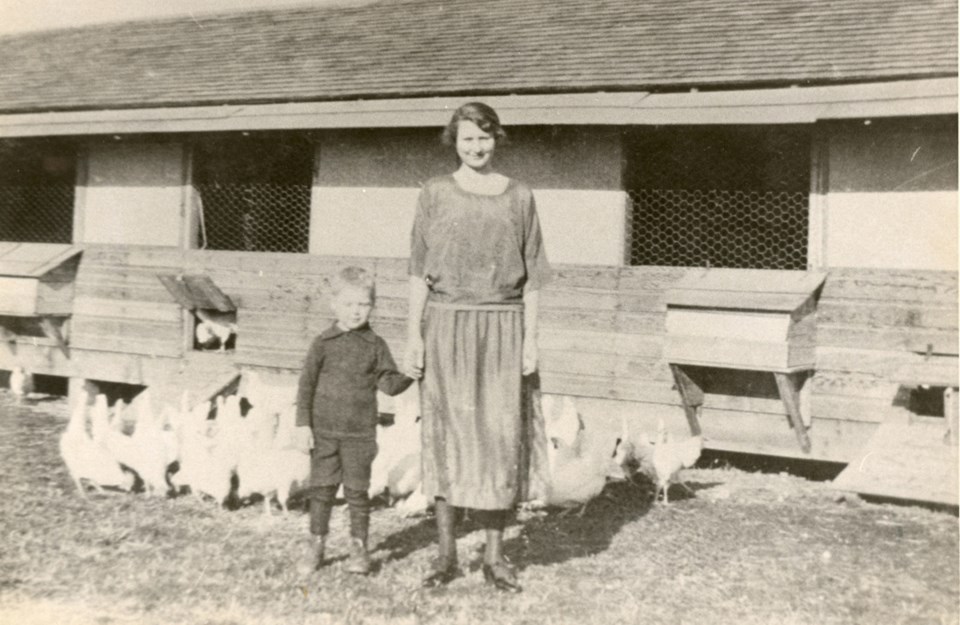I headed to Richmond Archives, convinced that early editions of the local paper contained the evidence to support a tantalising theory I’d formed. My search proved me wrong, but I came away with something rewarding all the same — glimpses of our community’s former life from a down-to-earth perspective.
Most of these windows to bygone times were in the classified ads, which listed not only goats, pigs and chickens but also real estate. Richmond properties regularly included chicken houses, cow sheds, root houses, fruit trees and berry bushes, because in the days before supermarkets and processed food, people grew and raised most of what they ate.
The lots were various sizes, usually large – in June 1935 six acres were for sale on Woodwards Road between No. 2 and No. 3, including a three-roomed house, chicken house and fruit trees. Half an acre of garden land was for sale on Bennett Road and described as a snap to the right buyer in November 1935. J. Brodowich advertised a piece of land for rent at the corner of No. 2 Road and Westminster Highway in June 1938. It had a house, chicken coop, barn, 15 fruit trees and seeded garden. Today it’s the site of a Chevron gas station.
Prices for sales and rentals are occasionally provided. In December 1937, 10 and a half acres, with house and buildings, were offered for a quick sale for $3,500, though the true cost was claimed to be over $8,000. The property didn’t sell, and a year later the owner declared it was a “Sacrifice, only $3,700 – terms.” Interested parties were to apply to 575 Geal Road, Woodwards Station.
Nowadays, the price of land is greater than that of a house, but in the early 20th century it was the reverse. In 1938, a five-room house with attic, on Garry Street and Fourth Avenue, was selling for $1,200. The average price for land was $300 per acre, according to a couple of ads from 1938 and 1941. A 66 ft. corner lot at Smith and Charles Streets in Bridgeport was advertised for $400 in January 1941.
Rents were high in relation to sale prices. In 1937, a new bungalow on Blundell Road, with living room, bedroom, sleeping porch, kitchenette, woodshed, garage, plus garden space, cost $15 a month to rent.
Richmond’s population increased by slightly more than 2,000 between 1931 and 1941, but already in May 1936 the paper ran the headline “Building Permits Are Up By Over $12,000,” continuing with the statement: “Richmond is experiencing something like a small building boom.” Vancouver’s new airport was being expanded (costs estimated at $33,000), and there was also considerable construction activity in the private sector, often with lumber supplied by Mr. Phil Buswell of Lulu Island Lumber. For example, the paper notes, W. H. Moore’s store on Douglas Road near the Diversion was under construction, while Joseph Jones had nearly finished his house on No. 3 Road, and Mr. Urkevitch was expanding his house on Cambie.
Meanwhile, in April 1936 the Richmond pioneer Eugene Greczmiel advertised that he was selling building materials from the demolished Vancouver Cannery on Sea Island.
Real estate agents began to proliferate in the 1940s. The Realty Investment Corporation, at 771 Dunsmuir, advertised in 1941 that it wanted listings and had clients waiting for “homes and small acreage.” Also A. I. Johnston of Lulu Island Real Estate, 488 No. 3 Road, cried for listings.
After World War II, Richmond’s real estate market went into high gear. The population almost doubled between 1941 (10, 370) and 1951 (19,186), and housing was in demand.
On Jan. 1, 1950, it was reported that council had upheld the new zoning bylaw, “when they turned down an application to subdivide with less than 66 feet frontage.” In February, the paper started running “House Suggestions,” with plans and drawings by the Small House Planning Bureau (St. Cloud, Minnesota). The house sizes ranged from 28 x 24 to 30 x 38 feet.
Between 1950 and 1951 three further agencies entered Richmond’s real estate market. By 1955, Newcombe Realty, Delta Realty and Rivers Realty were advertising in the paper, and Richmond Realty, at 688 No. 3 Road, had enough work to keep 10 salespeople (including women) busy.
House prices were climbing. A four-room stucco bungalow, with large fruit trees, close to school and bus, could be had for $4,200 (half in cash) in May 1951. Less than four years later, in February 1955, Richmond Realty advertised a two-bedroom house for $8,500; a bungalow on a corner lot for $11,500. The following year, the asking price for a two-bedroom house was $10,200, whereas a so-called executive house, with three bedrooms, cost $13,750. In April 1956, A. E. Austin & Co. placed an ad announcing: “Lots for sale / Attention Builders. 30 lots, choice location; $1,050 a lot, can be sold separately.” Curious, isn’t it, that 60 years later, it sounds strangely like the message on signs posted along some of Richmond’s arterial roads? Only the price tag has changed.
Sabine Eiche is a writer and art historian (members.shaw.ca/seiche)



